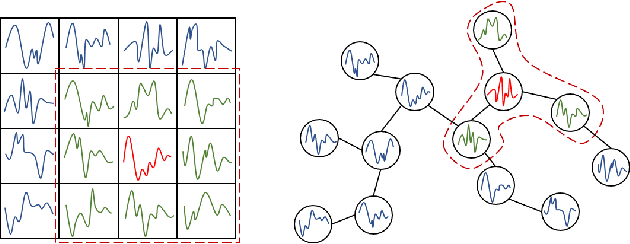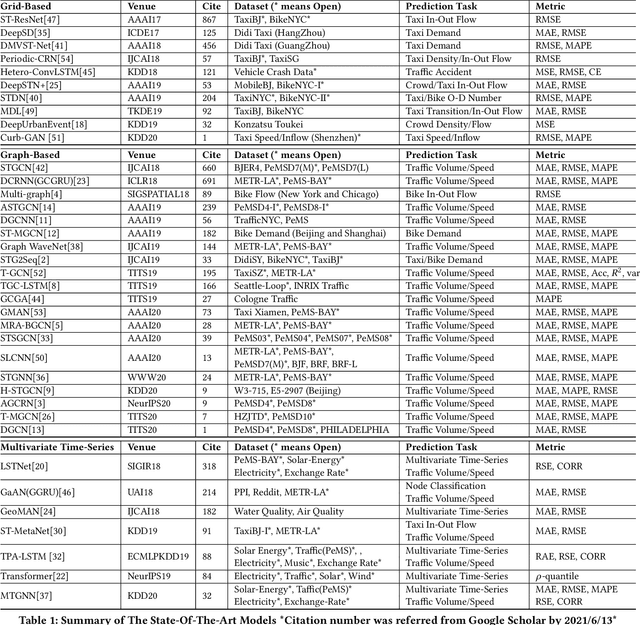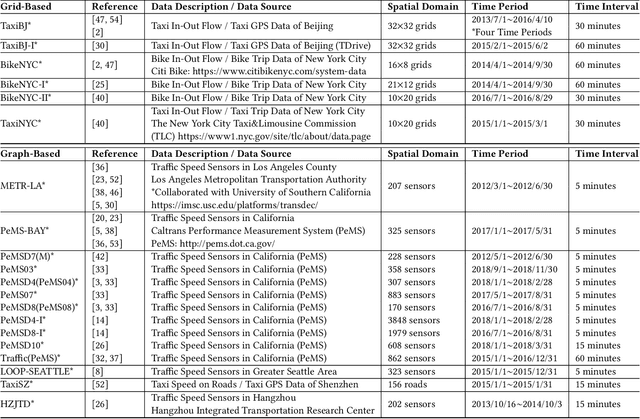Du Yin
STOAT: Spatial-Temporal Probabilistic Causal Inference Network
Jun 12, 2025Abstract:Spatial-temporal causal time series (STC-TS) involve region-specific temporal observations driven by causally relevant covariates and interconnected across geographic or network-based spaces. Existing methods often model spatial and temporal dynamics independently and overlook causality-driven probabilistic forecasting, limiting their predictive power. To address this, we propose STOAT (Spatial-Temporal Probabilistic Causal Inference Network), a novel framework for probabilistic forecasting in STC-TS. The proposed method extends a causal inference approach by incorporating a spatial relation matrix that encodes interregional dependencies (e.g. proximity or connectivity), enabling spatially informed causal effect estimation. The resulting latent series are processed by deep probabilistic models to estimate the parameters of the distributions, enabling calibrated uncertainty modeling. We further explore multiple output distributions (e.g., Gaussian, Student's-$t$, Laplace) to capture region-specific variability. Experiments on COVID-19 data across six countries demonstrate that STOAT outperforms state-of-the-art probabilistic forecasting models (DeepAR, DeepVAR, Deep State Space Model, etc.) in key metrics, particularly in regions with strong spatial dependencies. By bridging causal inference and geospatial probabilistic forecasting, STOAT offers a generalizable framework for complex spatial-temporal tasks, such as epidemic management.
Optimizing Electric Vehicle Charging Station Locations: A Data-driven System with Multi-source Fusion
Apr 18, 2025Abstract:With the growing electric vehicles (EVs) charging demand, urban planners face the challenges of providing charging infrastructure at optimal locations. For example, range anxiety during long-distance travel and the inadequate distribution of residential charging stations are the major issues many cities face. To achieve reasonable estimation and deployment of the charging demand, we develop a data-driven system based on existing EV trips in New South Wales (NSW) state, Australia, incorporating multiple factors that enhance the geographical feasibility of recommended charging stations. Our system integrates data sources including EV trip data, geographical data such as route data and Local Government Area (LGA) boundaries, as well as features like fire and flood risks, and Points of Interest (POIs). We visualize our results to intuitively demonstrate the findings from our data-driven, multi-source fusion system, and evaluate them through case studies. The outcome of this work can provide a platform for discussion to develop new insights that could be used to give guidance on where to position future EV charging stations.
Enhancing Spatio-temporal Quantile Forecasting with Curriculum Learning: Lessons Learned
Jun 18, 2024



Abstract:Training models on spatio-temporal (ST) data poses an open problem due to the complicated and diverse nature of the data itself, and it is challenging to ensure the model's performance directly trained on the original ST data. While limiting the variety of training data can make training easier, it can also lead to a lack of knowledge and information for the model, resulting in a decrease in performance. To address this challenge, we presented an innovative paradigm that incorporates three separate forms of curriculum learning specifically targeting from spatial, temporal, and quantile perspectives. Furthermore, our framework incorporates a stacking fusion module to combine diverse information from three types of curriculum learning, resulting in a strong and thorough learning process. We demonstrated the effectiveness of this framework with extensive empirical evaluations, highlighting its better performance in addressing complex ST challenges. We provided thorough ablation studies to investigate the effectiveness of our curriculum and to explain how it contributes to the improvement of learning efficiency on ST data.
XXLTraffic: Expanding and Extremely Long Traffic Dataset for Ultra-Dynamic Forecasting Challenges
Jun 18, 2024Abstract:Traffic forecasting is crucial for smart cities and intelligent transportation initiatives, where deep learning has made significant progress in modeling complex spatio-temporal patterns in recent years. However, current public datasets have limitations in reflecting the ultra-dynamic nature of real-world scenarios, characterized by continuously evolving infrastructures, varying temporal distributions, and temporal gaps due to sensor downtimes or changes in traffic patterns. These limitations inevitably restrict the practical applicability of existing traffic forecasting datasets. To bridge this gap, we present XXLTraffic, the largest available public traffic dataset with the longest timespan and increasing number of sensor nodes over the multiple years observed in the data, curated to support research in ultra-dynamic forecasting. Our benchmark includes both typical time-series forecasting settings with hourly and daily aggregated data and novel configurations that introduce gaps and down-sample the training size to better simulate practical constraints. We anticipate the new XXLTraffic will provide a fresh perspective for the time-series and traffic forecasting communities. It would also offer a robust platform for developing and evaluating models designed to tackle ultra-dynamic and extremely long forecasting problems. Our dataset supplements existing spatio-temporal data resources and leads to new research directions in this domain.
Learning Structured Components: Towards Modular and Interpretable Multivariate Time Series Forecasting
May 24, 2023



Abstract:Multivariate time-series (MTS) forecasting is a paramount and fundamental problem in many real-world applications. The core issue in MTS forecasting is how to effectively model complex spatial-temporal patterns. In this paper, we develop a modular and interpretable forecasting framework, which seeks to individually model each component of the spatial-temporal patterns. We name this framework SCNN, short for Structured Component-based Neural Network. SCNN works with a pre-defined generative process of MTS, which arithmetically characterizes the latent structure of the spatial-temporal patterns. In line with its reverse process, SCNN decouples MTS data into structured and heterogeneous components and then respectively extrapolates the evolution of these components, the dynamics of which is more traceable and predictable than the original MTS. Extensive experiments are conducted to demonstrate that SCNN can achieve superior performance over state-of-the-art models on three real-world datasets. Additionally, we examine SCNN with different configurations and perform in-depth analyses of the properties of SCNN.
DL-Traff: Survey and Benchmark of Deep Learning Models for Urban Traffic Prediction
Aug 20, 2021



Abstract:Nowadays, with the rapid development of IoT (Internet of Things) and CPS (Cyber-Physical Systems) technologies, big spatiotemporal data are being generated from mobile phones, car navigation systems, and traffic sensors. By leveraging state-of-the-art deep learning technologies on such data, urban traffic prediction has drawn a lot of attention in AI and Intelligent Transportation System community. The problem can be uniformly modeled with a 3D tensor (T, N, C), where T denotes the total time steps, N denotes the size of the spatial domain (i.e., mesh-grids or graph-nodes), and C denotes the channels of information. According to the specific modeling strategy, the state-of-the-art deep learning models can be divided into three categories: grid-based, graph-based, and multivariate time-series models. In this study, we first synthetically review the deep traffic models as well as the widely used datasets, then build a standard benchmark to comprehensively evaluate their performances with the same settings and metrics. Our study named DL-Traff is implemented with two most popular deep learning frameworks, i.e., TensorFlow and PyTorch, which is already publicly available as two GitHub repositories https://github.com/deepkashiwa20/DL-Traff-Grid and https://github.com/deepkashiwa20/DL-Traff-Graph. With DL-Traff, we hope to deliver a useful resource to researchers who are interested in spatiotemporal data analysis.
 Add to Chrome
Add to Chrome Add to Firefox
Add to Firefox Add to Edge
Add to Edge